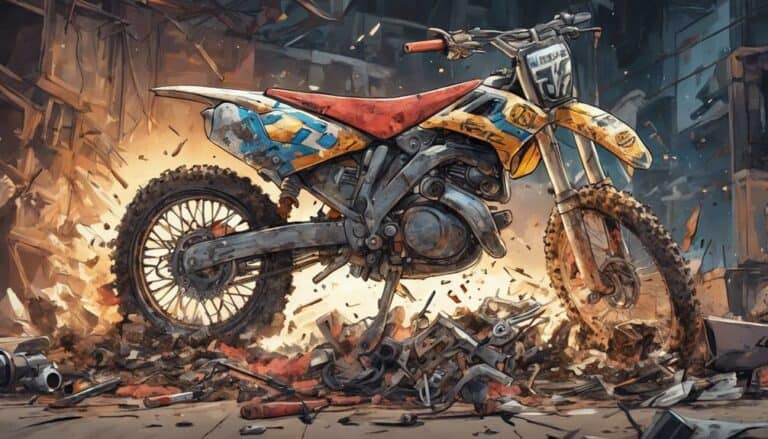To preserve your dirt bike for years of enjoyment, you must walk a fine line between proper care and neglect. But what if you were told that sometimes, to truly understand how to care for something, you must also know how to destroy it?
Imagine the possibilities that open up when you grasp the intricacies of both creation and destruction. Would you be intrigued to uncover the secrets that lie in dismantling a dirt bike, piece by piece, revealing the vulnerabilities that could lead to its demise?
Key Takeaways
- Neglect air filter maintenance, risking engine damage.
- Ignore warning signs, leading to decreased performance.
- Misuse fuel and oil, causing premature wear and damage.
- Overload the bike, stressing critical components and compromising safety.
Neglecting Regular Maintenance
Neglecting regular maintenance on your dirt bike can have serious consequences, impacting its performance and potentially leading to safety hazards. One critical aspect of maintenance often overlooked is the air filter. The air filter in dirt bikes plays a critical role in preventing dirt and debris from entering the engine. Failure to maintain or replace the air filter at recommended intervals can result in these particles finding their way into the engine, causing potential damage such as increased engine wear and reduced performance.
To guarantee performance and longevity of your dirt bike, it's essential to inspect and clean the air filter regularly. Depending on riding conditions, the air filter may need more frequent attention. A clogged or dirty air filter not only hinders performance but also puts your engine at risk. By neglecting this simple yet crucial maintenance task, you're setting the stage for potential engine problems and decreased overall performance on your dirt bike.
Ignoring Warning Signs
To ensure the proper functioning and longevity of your dirt bike, paying attention to warning signs is essential in preventing potential catastrophic engine failure and costly repairs. Your owner's manual is a valuable resource that outlines warning signs specific to your dirt bike model.
One common warning sign that riders often overlook is a dirty air filter. A clogged air filter restricts airflow to the engine, causing it to run rich and potentially leading to poor performance or engine damage over time. Ignoring this warning sign can result in decreased power output, reduced fuel efficiency, and even premature engine wear.
Moreover, warning lights on the dashboard should never be ignored, as they indicate underlying issues that require immediate attention. These lights serve as an early indicator of potential problems, allowing you to address them promptly and prevent further damage.
Using Incorrect Fuel or Oil
Incorrect fuel or oil usage in your dirt bike can have detrimental effects on its performance and longevity. Using fuel with the wrong octane rating can lead to engine knocking, reducing power output and potentially damaging engine components in the long run. Additionally, choosing an incorrect oil viscosity or type can result in inadequate lubrication, causing premature wear and potential engine damage.
Mixing different types of oil or fuel can lead to chemical reactions that are harmful to the engine, possibly resulting in costly repairs. Opting for cheap or low-quality fuel or oil may seem economical, but in the end, it can lead to poor engine performance and even breakdowns while riding. Neglecting to adhere to the manufacturer's recommendations for fuel and oil changes can accelerate engine wear and ultimately lead to engine failure, necessitating expensive repairs or replacements.
To guarantee your dirt bike's top performance and longevity, always use the recommended fuel and oil types and change them at the specified intervals.
Overloading the Bike
Avoid exceeding the recommended weight capacity of your dirt bike to prevent potential damage to its suspension, frame, and tires. When overloading the bike, you put stress on critical components, compromising its performance and safety. To maintain your dirt bike in peak condition, adhere to the manufacturer's guidelines regarding weight limitations.
- Follow Manufacturer Recommendations: Stick to the weight limits specified by the manufacturer to guarantee the bike functions as intended.
- Maintain Proper Balance: Overloading the bike can affect its balance, making it harder to handle and increasing the risk of accidents.
- Clean the Air Filter: As you carry heavy loads, the air filter may get clogged faster. Regularly clean the air filter to prevent engine issues and preserve performance.
Riding Recklessly
Reckless riding habits such as constantly redlining the engine can lead to overheating and significant engine damage. When you push the engine to its limits without allowing it to cool down, you risk causing irreparable harm. Ignoring the importance of warming up your bike properly before aggressive riding can result in premature wear and tear on essential engine components, ultimately leading to costly repairs.
Additionally, riding at high speeds without considering the terrain can put excessive stress on the suspension and frame, potentially causing structural damage over time.
Moreover, neglecting tire maintenance by riding on underinflated or damaged tires can compromise your control and increase the likelihood of accidents. Your safety depends on the condition of your tires, so it's critical to inspect them regularly.
Conclusion
To sum it up, neglecting essential maintenance tasks and riding recklessly can quickly turn your dirt bike into a heap of scrap metal. Remember, a well-maintained bike is a happy bike.
So, don't let laziness or carelessness be the wrecking ball that brings down your two-wheeled companion. Take care of your dirt bike like you'd a prized possession, and it will reward you with countless hours of exhilarating rides.

